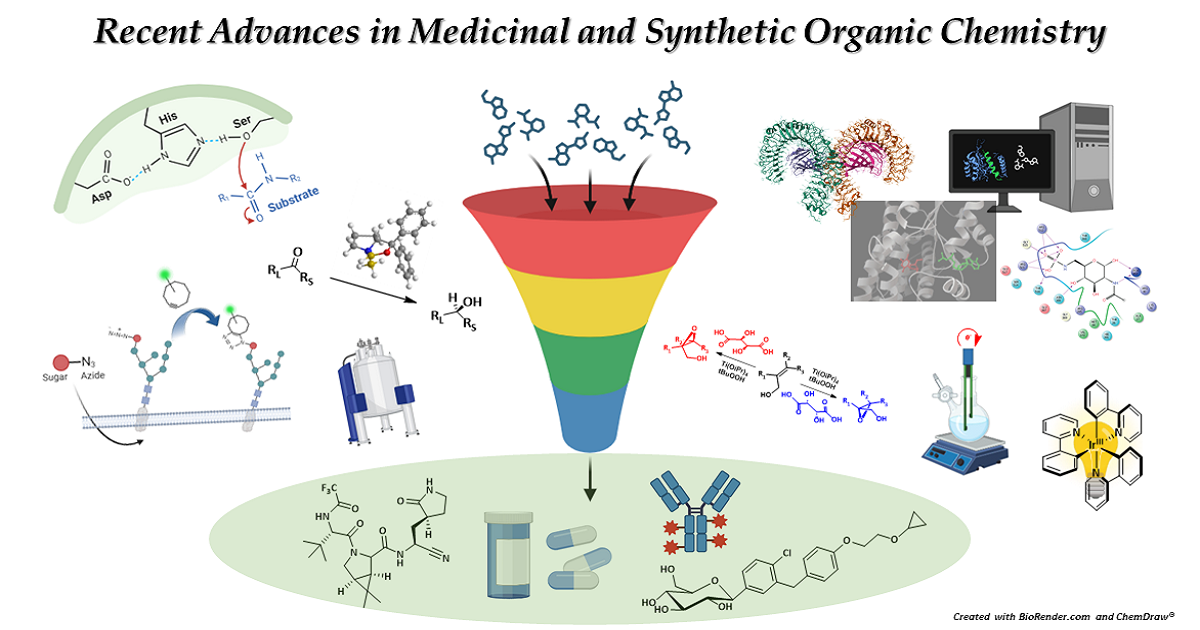Recent Advances in Medicinal and Synthetic Organic Chemistry
A special issue of Applied Sciences (ISSN 2076-3417). This special issue belongs to the section "Chemical and Molecular Sciences".
Deadline for manuscript submissions: closed (20 August 2024) | Viewed by 15489

Special Issue Editors
Interests: synthetic organic chemistry; medicinal chemistry; carbohydrate chemistry; chemical biology; synthetic chemistry and materials; agrochemicals
Special Issues, Collections and Topics in MDPI journals
Interests: synthetic organic chemistry; carbohydrate chemistry; glycoconjugates; biochemistry; glycolipid chemistry
Special Issues, Collections and Topics in MDPI journals
Interests: medicinal chemistry; organic chemistry; chemical biology; new antibacterial small molecules; new antiviral small molecules
Special Issues, Collections and Topics in MDPI journals
Special Issue Information
Dear Colleagues,
Medicinal chemistry is a constantly developing and evolving branch of life science research. It consists of the invention, discovery, design, identification and preparation of biologically active compounds. Synthetic organic chemistry, therefore, plays a key role in this type of research: the modification and manipulation of chemicals by increasingly emerging and innovative methods expand the possibility of synthesizing new compounds and molecules. The research for new methodologies, new classes of reactions, and new chemical entities represents attractive fields on which the efforts of thousands of researchers worldwide are focused. In recent years, discoveries in these fields have increased exponentially, making a significant contribution to the scientific community to overcome the continuing challenges that will need to be faced.
Therefore, the present Special Issue “Recent Advances in Medicinal and Synthetic Organic Chemistry” aims to collect significant and cutting-edge research works and bring out new ideas in the fields of Medicinal and Organic Chemistry, as short communications, full research papers, mini-reviews or full-length review paper. The Special Issue will consider recent works highlighting contributions on the following topics:
- Organic synthesis and innovative methodologies;
- Synthetic processes (including flow chemistry, microwave-assisted chemistry);
- Homogeneous and heterogeneous catalysis;
- Green chemistry;
- Medicinal chemistry;
- Agrochemicals and agro-drugs;
- Bio-organic chemistry and chemical biology;
- Natural products synthesis;
- Studies of the reaction mechanism;
- Synthetic materials and polymer chemistry.
Dr. Giuseppe D'Orazio
Dr. Laura Morelli
Dr. Sarah Mazzotta
Guest Editors
Manuscript Submission Information
Manuscripts should be submitted online at www.mdpi.com by registering and logging in to this website. Once you are registered, click here to go to the submission form. Manuscripts can be submitted until the deadline. All submissions that pass pre-check are peer-reviewed. Accepted papers will be published continuously in the journal (as soon as accepted) and will be listed together on the special issue website. Research articles, review articles as well as short communications are invited. For planned papers, a title and short abstract (about 250 words) can be sent to the Editorial Office for assessment.
Submitted manuscripts should not have been published previously, nor be under consideration for publication elsewhere (except conference proceedings papers). All manuscripts are thoroughly refereed through a single-blind peer-review process. A guide for authors and other relevant information for submission of manuscripts is available on the Instructions for Authors page. Applied Sciences is an international peer-reviewed open access semimonthly journal published by MDPI.
Please visit the Instructions for Authors page before submitting a manuscript. The Article Processing Charge (APC) for publication in this open access journal is 2400 CHF (Swiss Francs). Submitted papers should be well formatted and use good English. Authors may use MDPI's English editing service prior to publication or during author revisions.
Keywords
- organic synthesis
- innovative methodologies
- process chemistry
- catalysis
- green chemistry
- drugs
- natural products
- agrochemicals
- medicinal chemistry
- synthetic materials
Benefits of Publishing in a Special Issue
- Ease of navigation: Grouping papers by topic helps scholars navigate broad scope journals more efficiently.
- Greater discoverability: Special Issues support the reach and impact of scientific research. Articles in Special Issues are more discoverable and cited more frequently.
- Expansion of research network: Special Issues facilitate connections among authors, fostering scientific collaborations.
- External promotion: Articles in Special Issues are often promoted through the journal's social media, increasing their visibility.
- Reprint: MDPI Books provides the opportunity to republish successful Special Issues in book format, both online and in print.
Further information on MDPI's Special Issue policies can be found here.







